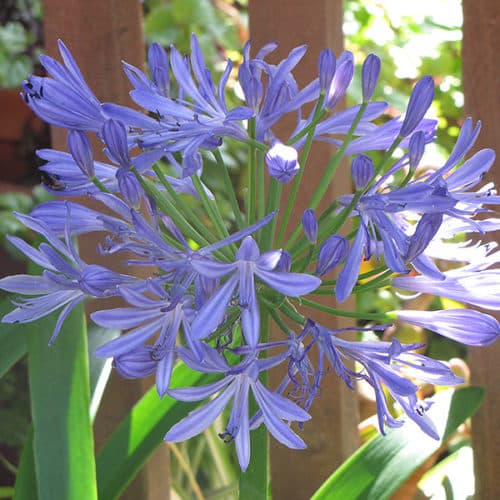Agapanthus Varieties: Choosing the very best for Your Landscape
Agapanthus Varieties: Choosing the very best for Your Landscape
Blog Article
Understanding the Art of Agapanthus Treatment: Essential Steps for Healthy Development and Vivid Blossoms
In the realm of gardening, the farming of agapanthus stands as a fulfilling undertaking for those who look for to support these classy flowering plants. From choosing the right selection to mastering pruning techniques, the journey in the direction of growing prospering agapanthus plants is multifaceted and holds the crucial to opening the full capacity of these herb gems.

Choosing the Right Agapanthus Selection

When selecting the ideal Agapanthus variety for your garden, think about aspects such as environment viability, flower color, and development behavior. Additionally, consider the environment in your region to ensure the Agapanthus selection you choose can flourish in your particular conditions. Recognizing the development habit of different Agapanthus ranges is vital for appropriate placement within your garden.
Suitable Planting Problems
Considering the optimal ecological requirements is important for successful Agapanthus cultivation. Agapanthus thrives in well-draining soil with a slightly acidic to neutral pH level. When growing, select a location that receives complete sunshine to partial color. In hotter climates, supplying some mid-day color can avoid scorching of the fallen leaves. Agapanthus plants are sensitive to cold temperatures and ought to be safeguarded from frost during winter season.
To ensure healthy and balanced development and lively flowers, plant Agapanthus light bulbs at a deepness of concerning 2-4 inches and area them 8-12 inches apart. Mulching around the base of the plants helps retain dampness and subdues weed growth.
Watering and Fertilizing Tips
Maintaining appropriate wetness levels and giving essential nutrients are vital components in the care regimen for Agapanthus plants. When it comes to sprinkling Agapanthus, it is critical to strike an equilibrium. These plants like regularly wet soil however are vulnerable to root rot if overwatered. During the growing period, water deeply as soon as a week, ensuring the soil is well-draining to stop waterlogging. In hotter climates or during durations of dry spell, even more constant watering might be essential to maintain the soil equally moist. Nonetheless, lower watering in the winter season to avoid water logged conditions.
Feeding Agapanthus is necessary for promoting healthy development and prolific blooms. Apply a balanced fertilizer, such as a 10-10-10 formula, in the very early springtime as brand-new development emerges. Repeat this application every 6-8 weeks throughout the expanding season. Stay clear of too much fertilization, as it can lead to lavish foliage at the expenditure of blossoms. Always adhere to the supplier's guidelines for proper dilution and application techniques. By following these watering and feeding suggestions, you can guarantee your Agapanthus plants grow and generate dynamic, lasting blossoms.
Pruning Strategies for Agapanthus
Pruning Agapanthus plants at the appropriate times and with appropriate techniques is critical for keeping their health and wellness and promoting ideal growth and flowering. The excellent time to trim Agapanthus is in late winter or very early spring prior to brand-new development arises.
For flowered stems, wait up until the blooms have withered and afterwards trim them back to the base. This not just cleans up the plant's look yet additionally encourages the development of new flower buds. Deadheading spent blossoms can likewise redirect the plant's power right into generating even more flowers instead of establishing seeds. Nonetheless, if you intend to accumulate seeds for proliferation, leave some blossoms to completely dry and fully grown on the plant.
Bear in mind to utilize tidy, sharp tools to make exact visit this page cuts and minimize the risk of presenting illness. Agapanthus. Normal trimming will certainly help maintain your Agapanthus looking healthy and balanced and neat while making certain a bountiful screen of stunning flowers
Handling Typical Pests and Diseases
After making certain correct pruning techniques for Agapanthus, it is important to attend to usual insects and conditions that can affect the wellness and vigor of these plants. Agapanthus plants are usually hardy however can still succumb to specific issues. One typical insect that influences Agapanthus is the Agapanthus gall midget. This tiny, orange go to my site fly lays its eggs in the vegetation, resulting in altered growth and flower buds that stop working to open up. To fight this pest, prune and ruin any affected plant parts and take into consideration making use of insecticidal soap.
Another typical concern is fungal leaf area, which offers as dark sores on the fallen leaves. To protect against fungal conditions, ensure great air blood circulation around the plants, prevent above watering, and get rid of any kind of infected leaves promptly. Furthermore, Agapanthus plants can struggle with root rot if they are grown in improperly draining pipes soil. To avoid this, plant Agapanthus in well-draining soil and prevent overwatering. By being attentive and taking punctual activity versus illness and parasites, you can aid your Agapanthus plants grow and generate lively blossoms.

Verdict
To conclude, see this understanding the art of agapanthus treatment entails choosing the right selection, supplying suitable growing conditions, correct watering and feeding, suitable trimming techniques, and dealing with usual bugs and illness. By following these crucial actions, you can guarantee healthy and balanced growth and dynamic blossoms for your agapanthus plants. Bear in mind to routinely check and preserve your plants to promote their general well-being and durability.
To ensure healthy growth and vivid flowers, plant Agapanthus light bulbs at a deepness of concerning 2-4 inches and area them 8-12 inches apart. By adhering to these watering and fertilizing suggestions, you can guarantee your Agapanthus plants flourish and generate dynamic, lasting blossoms.
One typical pest that affects Agapanthus is the Agapanthus gall midge. In addition, Agapanthus plants can experience from root rot if they are planted in inadequately draining soil. By following these essential steps, you can ensure healthy development and vivid blooms for your agapanthus plants.
Report this page